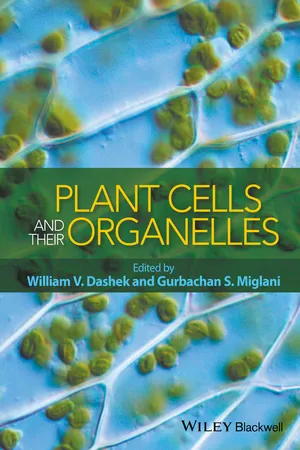
This is a test
- English
- ePUB (mobile friendly)
- Available on iOS & Android
eBook - ePub
Plant Cells and their Organelles
Book details
Book preview
Table of contents
Citations
About This Book
Plant Cells and Their Organelles provides a comprehensive overview of the structure and function of plant organelles. The text focuses on subcellular organelles while also providing relevant background on plant cells, tissues and organs. Coverage of the latest methods of light and electron microscopy and modern biochemical procedures for the isolation and identification of organelles help to provide a thorough and up-to-date companion text to the field of plant cell and subcellular biology. The book is designed as an advanced text for upper-level undergraduate and graduate students with student-friendly diagrams and clear explanations.
Frequently asked questions
At the moment all of our mobile-responsive ePub books are available to download via the app. Most of our PDFs are also available to download and we're working on making the final remaining ones downloadable now. Learn more here.
Both plans give you full access to the library and all of Perlego’s features. The only differences are the price and subscription period: With the annual plan you’ll save around 30% compared to 12 months on the monthly plan.
We are an online textbook subscription service, where you can get access to an entire online library for less than the price of a single book per month. With over 1 million books across 1000+ topics, we’ve got you covered! Learn more here.
Look out for the read-aloud symbol on your next book to see if you can listen to it. The read-aloud tool reads text aloud for you, highlighting the text as it is being read. You can pause it, speed it up and slow it down. Learn more here.
Yes, you can access Plant Cells and their Organelles by William V. Dashek, Gurbachan S. Miglani in PDF and/or ePUB format, as well as other popular books in Biological Sciences & Botany. We have over one million books available in our catalogue for you to explore.
Information
CHAPTER 1
An introduction to cells and their organelles
William V. Dashek
Retired Faculty, Adult Degree Program, Mary Baldwin College, Staunton, VA, USA
Cells
Parenchyma, chlorenchyma, collenchyma, and sclerenchyma are the four main plant cell types (Figure 1.1, Evert, 2006). Meristematic cells, which occur in shoot and root meristems, are parenchyma cells. Chlorenchyma cells contain chloroplasts and lack the cell wall thickening layers of collenchyma and sclerenchyma. Certain epidermal cells can be specialized as stomata that are important in gas exchange (Bergmann and Sack, 2007). The diverse cell types (Zhang et al., 2001; Yang and Liu, 2007) are shown in Table 1.1. Photomicrographs of certain of these cell types can be found in Evert (2006), Fahn (1990), Beck (2005), Rudall (2007), Gunning (2009), MacAdam (2009), Wayne (2009), Beck (2009), Assmann and Liu (2014) and Noguchi et al. (2014).

Figure 1.1 Plant cell types: Left: parenchyma (par) and collenchyma (co). Right: sclerenchyma.
Source: Evert (2006). Reproduced with permission of John Wiley & Sons.
Table 1.1 Plant cell types.
| Cell types | Characteristics | References |
| Epidermal cells | Unspecialized cells; one layer of cells in thickness; outer covering of various plant parts; variable in shape but often tabular | Evert (2006) |
| Examples | ||
| Guard cells | Specialized epidermal cells; crescent shaped; contain chloroplasts; form defines stomatal pore | Wille and Lucas (1984) |
| Subsidiary cells | Cells which subtend the stomatal guard cells | http://anubis.ru.ac.za/Main/ANATOMY/guardcells.html |
| Trichomes | An outgrowth of an epidermal cell; can be unicellular or multicellular | Callow (2000) |
| Parenchyma cells | Isodiametric, thin‐walled primary cell wall; in some instances may have secondary walls; not highly differentiated; function in photosynthesis, secretion, organic nutrient and water storage; regeneration in wound healing | Evert (2006) and Sajeva and Mauseth (1991) |
| Examples | ||
| Transfer cells | Specialized parenchyma cells; plasmalemma greatly expanded; irregular extensions of cell wall into protoplasm; transfer dissolved substances between adjacent cell; occur in pith and cortex of stems and roots; photosynthetic tissues of leaves; flesh of succulent fruits; endosperm of seeds | Dashek et al. (1971) and Offler et al. (2003) |
| Collenchyma cells | Lamellar or plate collenchyma, with thickenings on the tangential walls | |
| Vascular cells | Evert (2006) | |
| Phloem | ||
| Sieve cells | ||
| Sieve elements | ||
| Companion cells | Specialized parenchyma cells; possess numerous plasmodesmatal connections | Oparka and Turgeon (1999) |
| Albuminous cells in gymnosperms | Absence of starch; cytoplasmic bridges with sieve cells; dense protoplasm, abundance of polysomes, hig... |
Table of contents
- Cover
- Title Page
- Table of Contents
- Contributors
- Preface
- Acknowledgments
- CHAPTER 1: An introduction to cells and their organelles
- CHAPTER 2: Isolation and characterization of subcellular organelles from plant cells
- CHAPTER 3: Endoplasmic reticulum
- CHAPTER 4: The Golgi apparatus
- CHAPTER 5: Microbodies
- CHAPTER 6: Microtubules, intermediate filaments, and actin filaments
- CHAPTER 7: The mitochondrion
- CHAPTER 8: Nucleus
- CHAPTER 9: Plant cell walls
- CHAPTER 10: Plastid structure and genomics
- CHAPTER 11: Photosynthesis
- CHAPTER 12: Vacuoles and protein bodies
- CHAPTER 13: Systems biology in plant cells and their organelles
- APPENDIX A:
- APPENDIX B:
- APPENDIX C:
- Index
- End User License Agreement